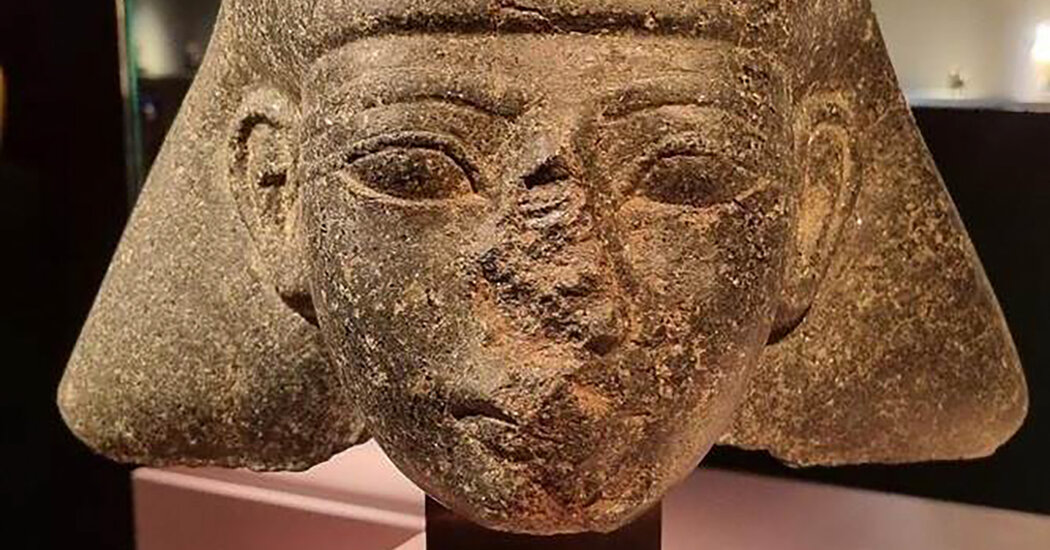Prime Minister Dick Schoof of the Netherlands announced during a visit to Cairo on Sunday that his country would return an ancient sculpture to Egypt after the artifact was determined to have been looted and illegally transported to a city in the Netherlands.
The artifact, a stone head from about 3,500 years ago, turned up at an art fair and exhibition in Maastricht in 2022, according to a news release from the Dutch Information and Heritage Inspectorate.
Dutch officials determined that it was stolen during the unrest of the Arab Spring in 2011 or 2012.
The Dutch government said it would return the artifact to the Egyptian ambassador to the Netherlands at the end of the year.
“Following an anonymous tip about the object’s illegal origin, the dealer voluntarily relinquished the sculpture,” the news release said.
The sculpture is of a high-ranking official from the dynasty of Pharaoh Thutmose III (ca. 1479-1425 B.C.), whose military campaigns solidified Egypt’s position as one of the region’s superpowers, according to the National Museum of Egyptian Civilization in Cairo.
The value of artifacts that had been stolen during the Arab Spring was “incalculable,” said Christopher A. Marinello, a lawyer who helps recover lost art.
During the revolution, sophisticated and systematic looting occurred across major Egyptian archaeological sites, according to Egyptian and U.S. officials. There were also instances, during the height of the Arab Spring, of local residents forming human chains to protect artifacts in museums.
Stolen pieces often turn up years later, in the United States or Europe. It was lucky, in some ways, that this sculpture turned up at TEFAF Maastricht (the European Fine Art Foundation) because it is known for adhering to a strict code of conduct, said Mr. Marinello, the founder and chief executive of Art Recovery International.
The artifact’s presence at such an elite air fair, where museums shop for items to add to their collections, speaks to its significance.
“Things don’t show up at Maastricht unless they are museum quality,” he said.
Dealers at Maastricht are high caliber and cooperative because they do not want the reputational risk of having an item that was concluded to have been stolen, Mr. Marinello said.
In contrast, he said, there are ongoing cases of Nazi-looted art in Germany in which he has presented the dealer with evidence that the piece was looted by Hermann Goering, founder and commander of the Luftwaffe, and the dealers still refuse to relinquish the pieces.
Mr. Schoof, the Dutch prime minister, was in Egypt for a two-day visit that coincided with the official opening of the new Grand Egyptian Museum. He met with President Abdel Fattah el-Sisi of Egypt, alongside leaders of Belgium and Luxembourg.
The Grand Egyptian Museum’s opening ceremony was a lavish nighttime extravaganza featuring dozens of dancers clad in white and gold Pharaonic costumes, dancing in orchestrated numbers outside the new museum and at the foot of the nearby pyramids and Great Sphinx of Giza.
The ancient site was backlit with colored lights as laser beams shot out toward massive drone light displays that shifted shapes, at one point forming the image of King Tutankhamen’s iconic gold funerary mask.
The entire country has been drawn into the museum opening hype. Squares across the country were fitted with screens to display the Saturday ceremony to crowds. Egyptian celebrities who posted A.I.-generated images of themselves dressed as ancient pharaohs sparked a social media trend, with ordinary Egyptians following suit and posting their own versions.
Erika Solomon contributed reporting from Cairo.
Jenny Gross is a reporter for The Times covering breaking news and other topics.
The post The Netherlands Will Return Looted Pharoah-Era Artifact to Egypt appeared first on New York Times.




